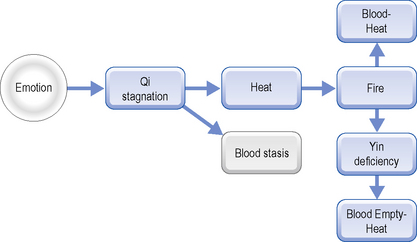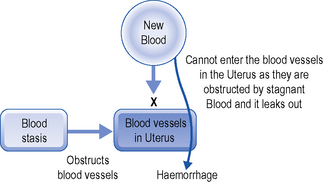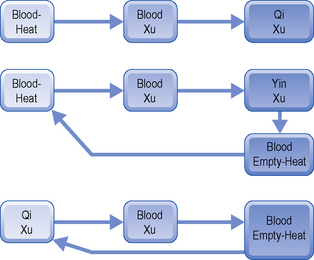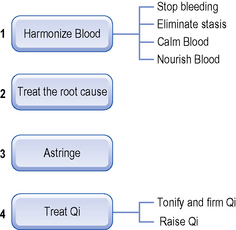CHAPTER 17 Flooding and Trickling
Flooding and Trickling encompasses two distinct symptoms, the former (Beng) indicating a period that starts suddenly with a flood, often before the proper time, and the latter (Lou) a period that continues with a trickle after the proper time. Flooding and Trickling should be distinguished from Heavy Periods (Ch. 11): the latter indicates heavy blood loss during the proper period time (about 5 days), with the periods coming at regular intervals, rather than the sudden, profuse and often early bleeding of Flooding. In terms of quantity, Flooding involves a heavier bleeding than Heavy Periods. In general, the pathology of Heavy Periods and of Flooding and Trickling is the same although the latter is a more serious condition and therefore more difficult to treat. See Figure S4.1 (p. 198).
The earliest reference to Flooding (Beng) is in Chapter 7 of the Simple Questions: “When Yin is deficient and Yang throbs, Flooding occurs”.1 In the context of this chapter, this statement refers to pulse diagnosis, i.e. when the Yin pulses are deficient and the Yang pulses forceful, a woman may suffer from Flooding. However, the statement may also be interpreted in a general sense, i.e. when Yin is deficient and Yang in excess, there may be Flooding because excess Yang heats the Blood and makes it spill from the blood vessels.
The Synopsis of Prescriptions from the Golden Cabinet mentions Trickling (Lou): “Continuous menstrual bleeding with an incessant trickling of dark blood [can be treated with] E Jiao Sheng Jiang Tang”.2 E Jiao Colla Corii asini is still widely used to stop uterine bleeding.
Aetiology
Emotional strain
Emotional problems may also cause bleeding in a different way, by leading to stagnation of Qi which will, in time, cause stasis of Blood. Stasis of Blood in the Uterus prevents new blood from taking its place and it therefore leaks out (Fig. 17.1).
Pathology
As for pathology, the major patterns in uterine bleeding are:
In addition to these five main pathological conditions, we also need to discuss:
Blood stasis
Blood stasis causes excessive blood loss during the period and also some blood loss before the proper period time. The blood is dark with dark clots and the period usually painful. Excessive bleeding from stagnant Blood is caused by the fact that stagnant Blood obstructs the Uterus and the blood vessels, newly-formed blood cannot take its normal place in the Uterus and blood vessels, and therefore leaks out (Fig. 17.2).
Thus, there are three major areas of pathology causing Flooding and Trickling. The first is Blood-Heat which may be Full or Empty; the second is deficiency, which may be of Qi/Yang (Spleen and Kidneys) or of Yin (Liver and Kidneys); the third is Blood stasis which usually is an aggravating rather than a causative factor (Table 17.1).
Table 17.1 Pathology of Flooding and Trickling
| Blood-Heat | Deficiency | Blood stasis |
|---|---|---|
| Blood Full-Heat (Liver and Heart) = Full condition | Qi deficiency (Spleen and Kidneys) | Blood stasis (Liver and Heart) |
| Blood Empty-Heat (Liver and Kidneys) = Full/Empty condition | Yin deficiency (Liver and Kidneys) |
The Jade Rule of Gynaecology says: “There are six major causes of Flooding and Trickling: Fire, Deficient Cold, Exhaustion (xulao), sinking Qi, Blood stasis and Deficiency”.3 Deficient Cold, mentioned in this text, is not a frequent cause of excessive menstrual bleeding. The Golden Mirror of Medicine (1742) relates Flooding and Trickling to the three basic conditions of Heat, Qi deficiency and Blood stasis:
Continuous dripping is called Lou, while a sudden flood is called Beng. Dark blood with clots and pain is due to Blood-Heat, after a long time it injures the Directing and Penetrating vessels. A deficient Spleen fails to hold Blood, Qi sinks, anger injures the Liver which makes Blood reckless: one must differentiate clearly, in Deficiency one must tonify, in stasis dissolve, and in Heat clear.4
Directing and Penetrating Vessels (Ren and Chong Mai) unstable
Flooding is due to injury of the Directing and Penetrating vessels. These vessels originate from the Uterus and are the Sea of channels; when they are injured their Qi becomes deficient and fails to hold Blood in the blood vessels and channels.5
Complex pathological conditions
The treatment principle I adopted was therefore to tonify Spleen- and Kidney-Qi, consolidate Directing and Penetrating Vessels and stop bleeding. I used a variation of the formula Yi Qi Gu Chong Tang Benefiting Qi and Consolidating the Penetrating Vessel Decoction (see below under Spleen not holding Blood).
Furthermore, Flooding and Trickling may interact with or cause one another. In fact, chronic flooding may lead to trickling and vice versa. A Chinese medicine saying states: “Flooding is an extreme form of Trickling; Trickling is the saturation of Flooding”. Figure 17.3 illustrates three possible complex pathological conditions resulting from bleeding.
Treatment principles
The treatment strategy for Flooding and Trickling is largely based on the general principles to stop bleeding.6 These were first advanced in the book Discussion of Blood Syndromes by Dr Tang Zong Hai (1884). There are four aims in the strategy to stop bleeding:
Let us now analyse these four treatment aims to stop bleeding with particular reference to gynecology (see Fig. 17.4).
Harmonize Blood
Treat the root cause of bleeding
The root cause of bleeding in Flooding and Trickling may be:
Blood-Heat
Herbal treatment
Some modern doctors place the emphasis on invigorating Blood and eliminating stasis for any type of Flooding and Trickling. For example, Dr Kuang Yi Huang advocates always invigorating Blood in this condition and combining this treatment method with cooling Blood, tonifying the Kidney or tonifying the Spleen according to clinical manifestations.7 The main rationale behind this approach is that stagnant blood obstructs the Uterus so that newly formed blood cannot take its proper place and leaks out. The following case history illustrates the importance of invigorating Blood in Flooding and Trickling.
Acupuncture
Harmonize Blood
This consists in the four steps:
Treat the root cause
Stop bleeding
Thus, the two main points to stop uterine bleeding are SP-8 Diji and KI-8 Jiaoxin.
Chapter 81 of the Spiritual Axis says:
If fluids are harmonized … in the Middle Burner, they are transformed into Blood, when Blood is harmonized it first fills and irrigates the Blood Connecting channels, then percolates to the Connecting channels and finally in the main channels.8
Treating Flooding and Trickling according to the four phases
I will therefore describe the treatment principle in each phase for each of the patterns.
Blood-Heat
Blood Empty-Heat
Blood stasis
Treatment principles
Treating Flooding and Trickling according to the four phases
Full conditions
Blood-Heat
Acupuncture
Herbal treatment
b. Prescription
Modifications
These modifications apply to both prescriptions above.
c. Prescription







